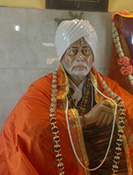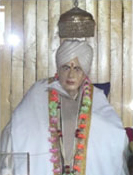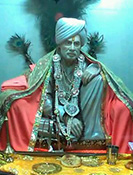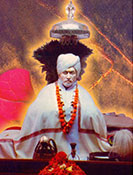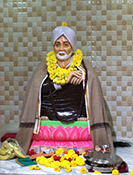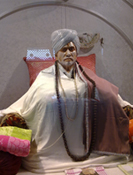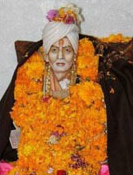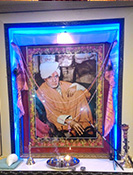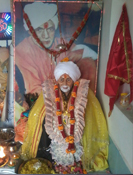Bhagavaan Ji would like to listen to the Indrakshi Stotram
Indrakshi is very powerful Mantra, recited in the homes and temples of Kashmir. Indrakshi is the compound word of Indra and Akshi. Indra is the Vedic Devata and Akshi means the eye. The purpose of the eye is to see, to visualise. Akshi also means the inner vision; hence the theme of the Indrakshi Stotram is about the vision of Indra. Vision in Hinduism is important because it implies visualization of the Satyam. Vision occurs within the person as opposed to outside. Hence, the eye of Indra is treated as the vision of Indra, which implies a more personal internal connection. Indrakshi means spiritual vision, not physical, which is finite in nature, only a Tattva of perception, is Akshi. Whenever perception transcends to the higher realms, it becomes a potent force, as it carries the grace of the Divine within.
Indra in this text is the Devata, or Godhead. Indra is both a Vedic and the Brahmanic God. According to the Puranas, Indra means the God of Rain, thunder, Lord of the clouds. Indra is associated to anything that has to do with rain. The Indra Devata's abode is the sky, and being the guardian deity of the rains, it has close proximity with Varuna Devata as well. Rain draws its source from the water, turns into clouds and transformed into rains, which falls from the sky.
Bab Ji is like the sky, but visible on the earth planet. His presence is felt, as we see the clouds and immediately our attention is drawn towards the rains. So is the grace of the saints. Bab is thus a saint extra-ordinary.
Bab Ji is essentially a worshipper of Shri sharika, along with Mahadeva Shiva.
Indrakshi is the cream of all the Shakti Devi Sahsranamas as Bhagwadgita is the essence of all the Upanishads. In today’s world where there is hurry every where, it is not possible to recite the Bhawani Sahsranama regularly, but Indrakshi recitation is done within a few minutes. The Sahsranamas carry one thousand words, including prologue and epilogue, but in case of the Indrakshi Pattham, only recition of Indrakshi Naam Sa Devi Devataa Samudaahrita ----etar naam padair Divyai Stutah shakrena Dheematah, stands as a Vajra for the safeguard of the Sadhaka.
Indrakshi is the Prithvi--the bhu shakti, revered as the Mother earth.She has both name and form, a component of Naama -Ruupa. She is a Divine Energy. All the natural forces adore her. She is also known as the Divine Mother, Durga, Shakti and Gauri. When she is dark, she is known as Kali.
Shakambari is mentioned in the passage, which is of the green color of the plantlife. Lush, wild and healthy, it is within the Prakriti aspect of the Spanda--vibration. Anything described through terms such as leaves represents the energy of God. So, Shakambari is representative of the energy of God through nature, through growth and plantlife. That is why, the green leaves are offered in the Havans, along with coconut and Samidha.
Bab Bhagavaan Ji would also recite the Bhavani Sahsranaama.
There stands an explanation as to the 1000 names of Devi, known as the Bhavani Sahsra Naama. Shunya known as zero is nothingness but it goes on adding their value in the multiplies of 10, when stands with any digit from 1 to 9. The number 1000 represents Brahma, Vishnu, and Shiva as a unifying force of Shri Maha Kali Maha Lakshmi and Maha Saraswati,as the unified Shakti of Maha Maya. EachZero ' 0' represents the Shakti of Brahma Vishnu and Shiva, while the 1 represents its unity. All the names represent creation, sustenanca and dissolution dissolution all in one.
Devata means divine beings or forces. The Pattham of the Bhawani Sahsranama represents devotees fondness and appreciation for nature and the Mother Earth. The divine forces within nature are known as Prakrati. This Prakriti is revered as Para-Prakriti in the Shakti Agamas.
He would adore the word Durga.
Durga has 36 names. There are 1000 names to this aspect of the divine, but only 36 belong to Durga. Maha Kali has 10 arms, Maha Lakshmi has 18 arms and Maha Saraswati has 8 arms. The 10 directions, when applied to this totality of arms, is equal to 360, which are the degrees on a circle. This symbol Shunya/ 0 in the Hindu Tantras, represents the center of the cosmos. It is the center point; another realm of this nothingness is the Vritta--a circle which is Mandalakar. It is not so much a sum as it is a placement within the Brahmanda--the universe. This is similar to the concept of one pointedness, focusing on a single point and not wavering. If so, then contemplating on the 36 arms of Durga, or meditating on the Center point which comes from the multiplication of the arms to the 10 directions (N, S, E, W, NE, SE, NW, SW, U, D) can bring that concept of one pointedness to fruition.
The names describe the interplay between the different forces of the universe, specifically those within the 1000 names of Devi. There is an inner reflection in order to view the microcosm of the universe within. What exists within is paralleled to what exists without, in a way like a blueprint of the universe. We belong to the divine and as such are a reflection of the sacred Vedic knowledge and the Agamic Shastras Recitation of the Mantras and shlokas become an expression, and hence a new formulation of what one has experienced, through Sadhana. In this way, the Sadhakas believe that the person reciting this Indrakshi and Bhawani sahsranama is for safety, and spiritual evolution.
Chaman Lal Raina






